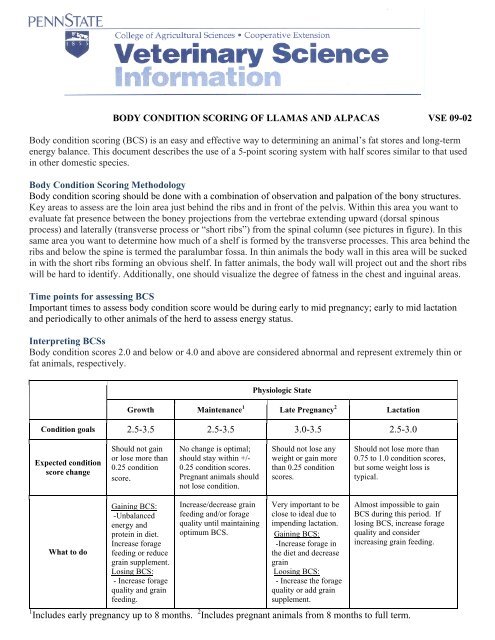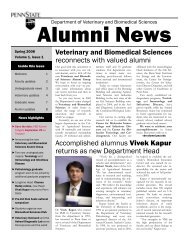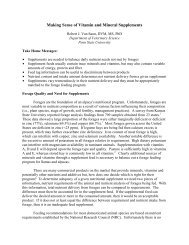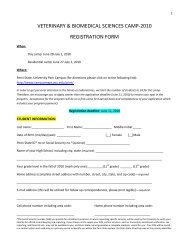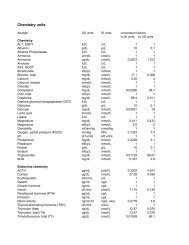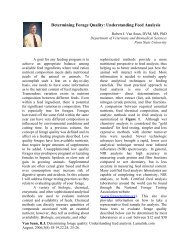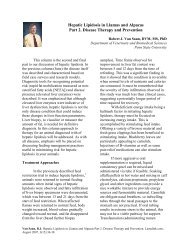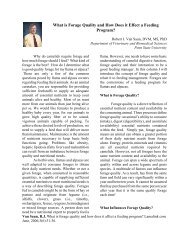Body Condition Scoring Fact Sheet
Body Condition Scoring Fact Sheet
Body Condition Scoring Fact Sheet
Create successful ePaper yourself
Turn your PDF publications into a flip-book with our unique Google optimized e-Paper software.
BODY CONDITION SCORING OF LLAMAS AND ALPACAS VSE 09-02<br />
<strong>Body</strong> condition scoring (BCS) is an easy and effective way to determining an animal’s fat stores and long-term<br />
energy balance. This document describes the use of a 5-point scoring system with half scores similar to that used<br />
in other domestic species.<br />
<strong>Body</strong> <strong>Condition</strong> <strong>Scoring</strong> Methodology<br />
<strong>Body</strong> condition scoring should be done with a combination of observation and palpation of the bony structures.<br />
Key areas to assess are the loin area just behind the ribs and in front of the pelvis. Within this area you want to<br />
evaluate fat presence between the boney projections from the vertebrae extending upward (dorsal spinous<br />
process) and laterally (transverse process or “short ribs”) from the spinal column (see pictures in figure). In this<br />
same area you want to determine how much of a shelf is formed by the transverse processes. This area behind the<br />
ribs and below the spine is termed the paralumbar fossa. In thin animals the body wall in this area will be sucked<br />
in with the short ribs forming an obvious shelf. In fatter animals, the body wall will project out and the short ribs<br />
will be hard to identify. Additionally, one should visualize the degree of fatness in the chest and inguinal areas.<br />
Time points for assessing BCS<br />
Important times to assess body condition score would be during early to mid pregnancy; early to mid lactation<br />
and periodically to other animals of the herd to assess energy status.<br />
Interpreting BCSs<br />
<strong>Body</strong> condition scores 2.0 and below or 4.0 and above are considered abnormal and represent extremely thin or<br />
fat animals, respectively.<br />
Growth Maintenance 1<br />
Physiologic State<br />
Late Pregnancy 2 Lactation<br />
<strong>Condition</strong> goals 2.5-3.5 2.5-3.5 3.0-3.5 2.5-3.0<br />
Expected condition<br />
score change<br />
What to do<br />
Should not gain<br />
or lose more than<br />
0.25 condition<br />
score.<br />
Gaining BCS:<br />
-Unbalanced<br />
energy and<br />
protein in diet.<br />
Increase forage<br />
feeding or reduce<br />
grain supplement.<br />
Losing BCS:<br />
- Increase forage<br />
quality and grain<br />
feeding.<br />
No change is optimal;<br />
should stay within +/-<br />
0.25 condition scores.<br />
Pregnant animals should<br />
not lose condition.<br />
Increase/decrease grain<br />
feeding and/or forage<br />
quality until maintaining<br />
optimum BCS.<br />
Should not lose any<br />
weight or gain more<br />
than 0.25 condition<br />
scores.<br />
Very important to be<br />
close to ideal due to<br />
impending lactation.<br />
Gaining BCS:<br />
-Increase forage in<br />
the diet and decrease<br />
grain<br />
Loosing BCS:<br />
- Increase the forage<br />
quality or add grain<br />
supplement.<br />
Should not lose more than<br />
0.75 to 1.0 condition scores,<br />
but some weight loss is<br />
typical.<br />
Almost impossible to gain<br />
BCS during this period. If<br />
losing BCS, increase forage<br />
quality and consider<br />
increasing grain feeding.<br />
1 Includes early pregnancy up to 8 months. 2 Includes pregnant animals from 8 months to full term.
Where trade names appear, no discrimination is intended, and no endorsement by Penn State Cooperative Extension is implied.<br />
Issued in furtherance of Cooperative Extension work, Acts of Congress May 8 and June 30, 1914, in cooperation with the U.S. Department of Agriculture and the Pennsylvania Legislature. T R<br />
Alter, Director of cooperative Extension, The Pennsylvania State University.<br />
The Pennsylvania State University is committed to the policy that all persons shall have equal access to programs, facilities, admission, and employment without regard to personal characteristics<br />
not related to ability, performance, or qualifications as determined by University policy or by state or federal authorities. The Pennsylvania State University does not discriminate against any<br />
person because of age, ancestry, color, disability or handicap, national origin, race, religious creed, sex, sexual orientation, or veteran status. Direct all inquiries regarding the nondiscrimination<br />
policy to the Affirmative Action Director, The Pennsylvania State University, 201 Willard Building, University Park, PA 16802-2801; 814-865-4700.


